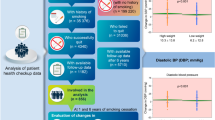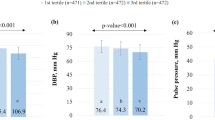Abstract
OBJECTIVE:
To examine the relationship between having a regular physician, results of screening tests for cardiovascular risk (hypertension, hypercholesterolemia) and efforts to lose weight among obese adults.
DESIGN:
Analysis of a population-based telephone survey (2002 Behavioral Risk Factor Surveillance System).
SETTING:
Four states (Iowa, South Carolina, South Dakota, Virginia) in the US.
PARTICIPANTS:
Adults (≥18 y old) who were obese (body mass index ≥30 kg/m2) (unweighted n=1735).
MAIN OUTCOME MEASURES:
Currently attempting to lose weight; changes in diet or exercise as strategies to lose weight.
RESULTS:
Obese individuals with a personal physician were more likely to report attempts to lose weight in the face of screening normal for hypertension or hypercholesterolemia than those without a personal physician (75.6 vs 60.5% for hypercholesterolemia, P=0.03; 74.6 vs 57.7% for hypertension, P=0.01). In adjusted models, obese individuals screening normal for hypertension but having a personal physician were significantly more likely to attempt to lose weight than individuals without a personal physician (OR 1.71, 95% CI 1.12–2.60).
CONCLUSIONS:
Having a regular physician is associated with a higher likelihood of attempted weight loss among obese individuals who believe that they do not have hypertension or hypercholesterolemia, than their counterparts with no regular physician. This suggests a previously unrecognized benefit of having a personal physician.
This is a preview of subscription content, access via your institution
Access options
Subscribe to this journal
Receive 12 print issues and online access
$259.00 per year
only $21.58 per issue
Buy this article
- Purchase on Springer Link
- Instant access to full article PDF
Prices may be subject to local taxes which are calculated during checkout
Similar content being viewed by others
References
Otten Jr MW, Zaidi AA, Wroten JE, Witte JJ, Peterman TA . Changes in sexually transmitted disease rates after HIV testing and posttest counseling, Miami, 1988 to 1989. Am J Public Health 1993; 83: 529–533.
Aubin M, Godin G, Vezina L, Maziade J, Desharnais R . Hypercholeterolemia screening: does knowledge of blood cholesterol level affect dietary fat intake? Can Fam Physician 1998; 44: 1289–1297.
Scheer JK, Loper D, Wagner L, Wise S . The effect of cholesterol screening on college students. J Am Coll Health 1992; 41: 106–110.
Nichol KL, Azar MM, Basara ML . Cholesterol screening for blood donors: characteristics of screenees and determinants of follow-up behavior. Am J Prev Med 1993; 9: 231–236.
Galuska DA, Will JC, Serdula MK, Ford ES . Are health care professionals advising obese patients to lose weight? JAMA 1999; 282: 1576–1578.
Sciamanna CN, Tate DF, Lang W, Wing RR . Who reports receiving advice to lose weight? Results from a multistate survey. Arch Intern Med 2000; 160: 2334–2339.
Kerse N, Buetow S, Mainous III AG, Young G, Coster G, Arroll B . Physician-patient relationship and medication compliance: a primary care investigation. Ann Fam Med 2004; 2: 455–461.
Charney E, Bynum R, Eldredge D, Frank D, MacWhinney JB, McNabb N, Scheiner A, Sumpter EA, Iker H . How well do patients take oral penicillin—A collaborative study in private practice. Pediatrics 1967; 40: 188–195.
O’Malley AS, Mandelblatt J, Gold K, Cagney KA, Kerner J . Continuity of care and the use of breast and cervical cancer screening services in a multiethnic community. Arch Intern Med 1997; 157: 1462–1470.
Mainous III AG, Koopman RJ, Gill JM, Baker R, Pearson WS . The relationship between continuity of care and diabetes control: evidence from the Third National Health and Nutrition Examination Survey. Am J Public Health 2004; 94: 66–70.
Brownson RC, Jackson-Thompson J, Wilkerson JC, Kiani F . Reliability of information on chronic disease risk factors collected in the Missouri Behavioral Risk Factor Surveillance System. Epidemiology 1994; 5: 545–549.
The clinical guidelines on the identification, evaluation, and treatment of overweight and obesity in adults: the evidence report. NIH Publication No. 98-408. National Institutes of Health: Bethesda, MD; 1998.
Research Triangle Institute. SUDAAN language manual, Release 9.0. Research Triangle Institute: Research Triangle Park, NC; 2004.
Mainous III AG, Baker R, Love MM, Gray DP, Gill JM . Continuity of care and trust in one's physician: evidence from primary care in the United States and the United Kingdom. Fam Med 2001; 33: 22–27.
Love MM, Mainous III AG . Commitment to a regular physician: how long will patients wait to see their own physician for acute illness? J Fam Pract 1999; 48: 202–207.
Love MM, Mainous III AG, Talbert JC, Hager GL . Continuity of care and the physician–patient relationship: the importance of continuity for adult patients with asthma. J Fam Pract 2000; 49: 998–1004.
Mainous III AG, Goodwin MA, Stange KC . Patient–physician shared experiences and value patients place on continuity of care. Ann Fam Med 2004; 2: 452–454.
Nutting PA, Goodwin MA, Flocke SA, Zuzanski SJ, Stange KC . Continuity of primary care: to whom does it matter and when? Ann Fam Med 2003; 1: 149–155.
Roland ML . Self-reported weight and height. Am J Clin Nutr 1990; 52: 1125–1133.
Acknowledgements
This study was funded in part through Grants 1 D14 HP 00161-02 and 1D12HP00023-03 from the Health Resources and Services Administration.
Author information
Authors and Affiliations
Corresponding author
Rights and permissions
About this article
Cite this article
Mainous, A., Diaz, V., Koopman, R. et al. Having a regular physician and attempted weight loss after screening for hypertension or hypercholesterolemia. Int J Obes 29, 223–227 (2005). https://doi.org/10.1038/sj.ijo.0802863
Received:
Revised:
Accepted:
Published:
Issue Date:
DOI: https://doi.org/10.1038/sj.ijo.0802863
Keywords
This article is cited by
-
Factors Related to Weight Loss Attempt Among Dominican Immigrants
Journal of Immigrant and Minority Health (2013)
-
Health Perceptions and Demographic Characteristics Associated With Underassessment of Body Weight
Obesity (2008)



